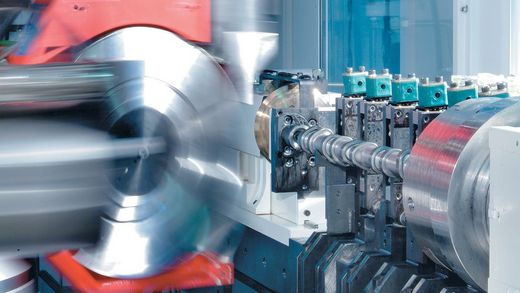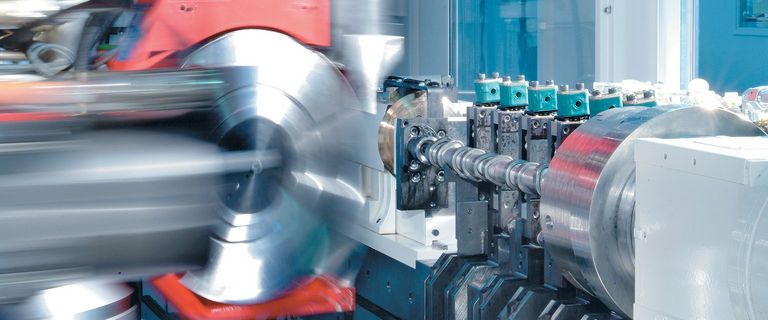The Advantages of an ID/OD Grinder for High-Precision Manufacturing
Nowhere is the goal of CNC grinding machine manufacturers more apparent than with ID/OD grinders: They seek to find ways to keep a part in the machine as long as possible to do as many operations as possible.
This is because high-precision manufacturers desire to limit or completely eliminate the need to handle parts during production. This drives higher quality with repeatable precision and efficiency with fewer machine setup changes and transfers of parts.
Today, advances in universal cylindrical ID/OD grinding technology have made great strides in this area, offering greater flexibility and more refined work while being easier to operate. STUDER ID/OD grinders, for example, hold up to four wheels with various combinations of ID and OD spindles, which combine to allow a single setup for many complex processes. Advances in software, grinding wheel technology, dressing processes, and measurements allow our ID/OD grinders to do in one operation what previously took up to five machines, even with difficult-to-machine materials and tight tolerances.
Flexibility Is Attractive for High-Complexity Work
ID/OD grinders permit grinding from flexible positions and allow different operations in the same setup. This versatility creates opportunities to do things differently, which can help increase the number of operations that can be completed in the same clamping.
The types of grinds possible on universal cylindrical machines include:
- Internal
- External
- Shoulder
- Taper
- Face
- Plunge
- Surface
STUDER’s popularity with aerospace manufacturers is due to versatility combined with the ability to meet tight tolerances with hard-to-machine materials. For example:
- Out-of-round shapes like squares and hexagons can be done using ID or OD spindles, depending on the part geometry.
- Bearings manufacturers can grind the OD of the ring and ID of the race without unclamping a workpiece.
- Large parts, such as shafts and gears, or small parts such as ball screws and threads can all be ground in a single setup.
The flexibility of our ID/OD grinders have made them attractive for high mix, low volume work (HMLV), which appears to be the new norm. With so many industries turning to complex materials for long-lasting parts, these universal grinders are valued for their ability to handle a variety of high-complexity work.
Automation Options Abound with ID/OD Grinders
Whenever the grinding machine door is opened for additional handling or measuring, it adds time to the part cycle and introduces possible errors. Reducing handling and transferring of parts not only improves quality, it also may allow an operator to work on two or more machines at once.
ID/OD grinder automation can be realized with chucking, barcoding, washing, demag, deburr, measuring, laser making and more. A STUDER ID/OD grinding machine equipped with a flexLoad robot performs over 90 percent of the necessary labor per shift.
Advances with Probes, Software Boost Customization Options, Quality
The newest universal cylindrical grinding machines integrate more advanced probe capabilities, measuring multiple diameters in nanometers instead of microns. A shop can run an operation, have the probe check the part and, if needed, tweak the program on-the-fly.
Grinding software also is getting more sophisticated in capabilities while becoming easier to use. This allows manufacturers to not only customize operations but also reduces the learning curve for new operators and allows more applications to be programmed while the machine operates.
With easy-to-use HMIs, some shop managers are putting their least experienced operators on some of their most expensive machines since the software has become better at calculating and suggesting process parameters, so that parts can be produced repeatedly with the desired accuracies and surface finishes.
ID/OD Grinder Flexibility Provides More Options for Grinding Wheels, Finishing
The flexibility of ID/OD grinders also allows for more options with grinding wheels. Having multiple spindles can accommodate high material removal with one wheel, then a medium cut and a finer cut with the same clamping, which often eliminates the need for a separate finishing operation.
The ability to swivel the workpiece allows for straight wheels to create more complex forms while saving time by not having to change to a formed wheel. Straight wheels usually are less expensive and more likely to be in stock. Plus, they last longer than formed wheels.
The possibilities can get more elaborate, too. For example, an aerospace part might be coated with carbide, which requires a diamond wheel, but the substrate is alloy or steel, which would require a different wheel. An ID/OD grinder with multiwheel capabilities may be able to process the entire part, avoiding additional setups and associated issues.
STUDER has a wide range of universal grinders for producing various sized parts. The machines are designed with geometry in mind — to be able to reach as large of a swing diameter of the tool as possible for grinding and be able to dress the wheel in more positions at the same time. This increases the flexibility of the machine, and allows ID/OD grinders to provide many capabilities within a small footprint, which is important for shops with limited floor space.
STUDER Sets Standard with Emphasis on Thermal Stability
With more operations done on a single clamping, STUDER has put a big focus on thermal stability because it allows for tighter tolerances and more accurate results. Even opening the doors of a grinding machine to remove parts can create issues with temperature control. STUDER has developed the ability to run all of the spindles at the same time, which keeps them warm and ready for use, reducing size variation. Controlling the temperature applies not only to the grinding wheel but also the entire machine base and machine elements to create a more stable process.
Contact us today to discuss how we can collaborate to solve your challenges and get the most out of your grinding technology, whether that’s via an ID/OD grinder or other grinding machines designed for high-complexity applications.









